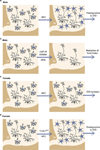Glia: silent partners in energy homeostasis and obesity pathogenesis
- PMID: 27986987
- PMCID: PMC5253392
- DOI: 10.1007/s00125-016-4181-3
Glia: silent partners in energy homeostasis and obesity pathogenesis
Abstract
Body weight stability requires homeostatic regulation to balance energy intake and energy expenditure. Research on this system and how it is affected by obesity has largely focused on the role of hypothalamic neurons as integrators of information about long-term fuel storage, short-term nutrient availability and metabolic demand. Recent studies have uncovered glial cells as additional contributors to energy balance regulation and obesity pathogenesis. Beginning with early work on leptin signalling in astrocytes, this area of research rapidly emerged after the discovery of hypothalamic inflammation and gliosis in obese rodents and humans. Current studies have revealed the involvement of a wide variety of glial cell types in the modulation of neuronal activity, regulation of hormone and nutrient availability, and participation in the physiological regulation of feeding behaviour. In addition, one glial type, microglia, has recently been implicated in susceptibility to diet-induced obesity. Together, these exciting new findings deepen our understanding of energy homeostasis regulation and raise the possibility of identifying novel mechanisms that contribute to the pathogenesis of obesity.
Keywords: Astrocytes; Brain; Central nervous system; Diabetes; Energy homeostasis; Glia; Hypothalamus; Inflammation; Microglia; Obesity; Review.
Figures



Similar articles
-
Molecular mechanisms of central leptin resistance in obesity.Arch Pharm Res. 2013 Feb;36(2):201-7. doi: 10.1007/s12272-013-0020-y. Epub 2013 Jan 29. Arch Pharm Res. 2013. PMID: 23359004 Review.
-
Glial cells and energy balance.J Mol Endocrinol. 2017 Jan;58(1):R59-R71. doi: 10.1530/JME-16-0182. Epub 2016 Nov 18. J Mol Endocrinol. 2017. PMID: 27864453 Review.
-
Hypothalamic Wnt Signalling and its Role in Energy Balance Regulation.J Neuroendocrinol. 2016 Mar;28(3):12368. doi: 10.1111/jne.12368. J Neuroendocrinol. 2016. PMID: 26802435 Free PMC article. Review.
-
Hypothalamic inflammation and malfunctioning glia in the pathophysiology of obesity and diabetes: Translational significance.Biochem Pharmacol. 2018 Jul;153:123-133. doi: 10.1016/j.bcp.2018.01.024. Epub 2018 Jan 11. Biochem Pharmacol. 2018. PMID: 29337002 Review.
-
Glial Regulation of Energy Metabolism.Adv Exp Med Biol. 2018;1090:105-121. doi: 10.1007/978-981-13-1286-1_6. Adv Exp Med Biol. 2018. PMID: 30390287 Review.
Cited by
-
Hypothalamic Microglial Heterogeneity and Signature under High Fat Diet-Induced Inflammation.Int J Mol Sci. 2021 Feb 24;22(5):2256. doi: 10.3390/ijms22052256. Int J Mol Sci. 2021. PMID: 33668314 Free PMC article. Review.
-
Metabolic Changes Induced by Purinergic Signaling: Role in Food Intake.Front Pharmacol. 2021 Apr 29;12:655989. doi: 10.3389/fphar.2021.655989. eCollection 2021. Front Pharmacol. 2021. PMID: 33995077 Free PMC article. Review.
-
Glucose transporter-2 regulation of VMN GABA neuron metabolic sensor and transmitter gene expression.Sci Rep. 2024 Jun 20;14(1):14220. doi: 10.1038/s41598-024-64708-y. Sci Rep. 2024. PMID: 38902332 Free PMC article.
-
Obesity Accelerates Alzheimer-Related Pathology in APOE4 but not APOE3 Mice.eNeuro. 2017 Jun 13;4(3):ENEURO.0077-17.2017. doi: 10.1523/ENEURO.0077-17.2017. eCollection 2017 May-Jun. eNeuro. 2017. PMID: 28612048 Free PMC article.
-
Synaptic plasticity and the role of astrocytes in central metabolic circuits.WIREs Mech Dis. 2024 Jan-Feb;16(1):e1632. doi: 10.1002/wsbm.1632. Epub 2023 Oct 13. WIREs Mech Dis. 2024. PMID: 37833830 Free PMC article. Review.
References
-
- Schwartz MW, Woods SC, Porte D, Jr, Seeley RJ, Baskin DG. Central nervous system control of food intake. Nature. 2000;404:661–671. - PubMed
-
- Barsh GS, Farooqi IS, O'Rahilly S. Genetics of body-weight regulation. Nature. 2000;404:644–651. - PubMed
-
- Zhang Y, Proenca R, Maffei M, Barone M, Leopold L, Friedman JM. Positional cloning of the mouse obese gene and its human homologue. Nature. 1994;372:425–432. - PubMed
Publication types
MeSH terms
Grants and funding
LinkOut - more resources
Full Text Sources
Other Literature Sources
Medical

